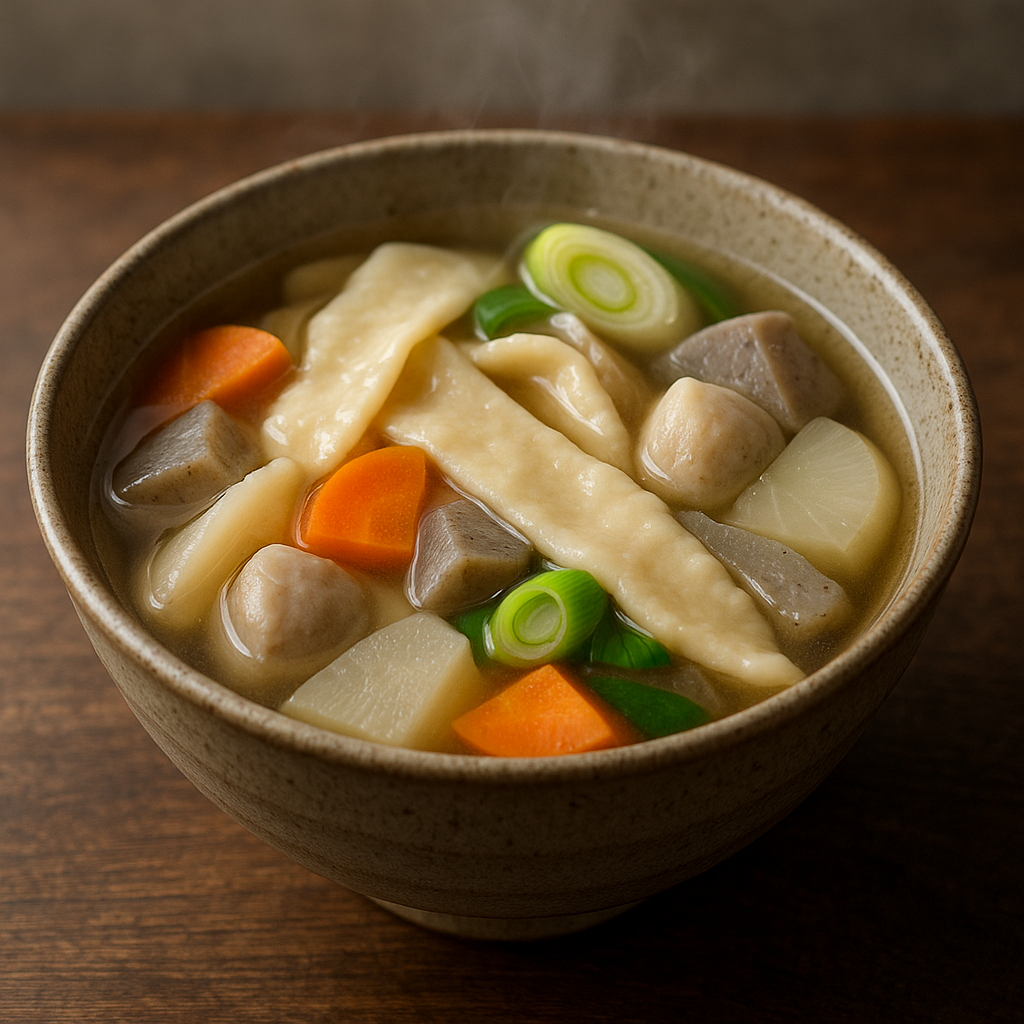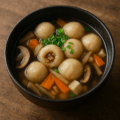ひっつみ汁(岩手)の特徴
手で“ひっつまんで”落とす、南部地方の粉もの汁
岩手を代表する郷土料理「ひっつみ汁」は、塩をきかせた小麦生地を手で薄くのばしてちぎり、煮立つ鍋へ直接落として煮る一椀。名前は生地を“ひっつまむ(つまむ)”所作に由来します。
もちっと薄のばし、つるりと喉ごし
生地は耳たぶ程度にこねて休ませ、1〜2mmまで薄くのばしてちぎるのが基本。不揃いのふちが汁をまとい、つるりとした喉ごしと素朴な弾力が楽しめます。
鶏だし×根菜の滋味、味噌仕立ても定番
鶏もも・ごぼう・にんじん・きのこ・長ねぎなどを醤油ベースで煮るのが一般的。地域や家庭によって味噌仕立ても親しまれ、季節の野菜で一年中楽しめます。
ひっつみ汁(岩手)のレシピ
材料(4人分)
- ひっつみ生地:薄力粉または中力粉 200g/塩 小さじ1/3/水 110〜130ml(様子を見て)
- 具:鶏もも肉 200g(一口大)/ごぼう 1/2本(ささがき)/にんじん 1/2本(短冊)/しいたけ 3〜4枚(薄切り)/長ねぎ 1本(斜め切り)
- だし・調味:だし 900ml(昆布+かつお、または鶏がらでも可)/酒 大さじ1/みりん 大さじ1/醤油 大さじ2〜3/塩 少々
作り方
- 生地:粉と塩を混ぜ、水を少しずつ加えてこねる(3〜4分)。耳たぶ程度になったらラップで包み、30分以上休ませる。
- だし:鍋にだしを沸かし、鶏肉を入れてアクを取る。ごぼう・にんじん・しいたけを加え、中火で7〜8分煮る。
- のばしてちぎる:生地を手に取り、指で薄く引きのばしながら一口大にちぎる(1〜2mm厚)。沸いた鍋へ直接落とす。
- 煮る・調味:生地をすべて落としたら、みりん・醤油・酒で調味。2〜3分煮て火を通し、長ねぎを加えてひと煮立ち。塩で味を整える。
- 仕上げ:火を止めて1〜2分休ませ、椀によそう。
シェフのワンポイントアドバイス
- 生地は休ませるほど伸びが良くなります。薄く不揃いにのばすと食感に抑揚が出ます。
- 手に軽く水をつけると扱いやすく、打ち粉は基本不要。
- 味噌仕立てにする場合は醤油を減らし、仕上げに味噌大さじ1〜2を溶き入れてください。
栄養価(1杯の目安)
- エネルギー:約320〜430 kcal
- たんぱく質:18〜25 g
- 脂質:8〜14 g
- 炭水化物:45〜60 g(生地・野菜由来)
歴史
粉食文化と“手ちぎり”の知恵から
米が乏しい季節の腹持ちの良い食事として南部地方に広まり、来客のもてなしや行事のごちそうにも用いられてきました。宮城の「はっと」、青森の「つめり」など呼び名や仕立てに地域差がありますが、手延べ・手ちぎりの素朴な技は共通です。
English Version
Features of Hittsumi-jiru (Iwate)
Hand-pinched dough dropped straight into the pot
Hittsumi-jiru is a signature soup of Iwate’s Nanbu region. A salted wheat dough is stretched thin by hand, pinched off, and dropped directly into a simmering pot. The name comes from the local verb meaning “to pinch and pull off.”
Thin and chewy, with a silky swallow
The dough is kneaded to a soft “earlobe” texture, rested, then stretched to 1–2 mm before tearing. The irregular edges catch the broth nicely, giving gentle chew and a smooth finish.
Comforting chicken broth with roots and mushrooms
Common versions are soy-sauce based with chicken thigh, burdock root, carrot, mushrooms, and leek; miso-based styles are also popular and vary by season and household.
Recipe
Ingredients (Serves 4)
- Dough: all-purpose (or medium-gluten) flour 200 g; salt 1/3 tsp; water 110–130 ml (as needed)
- Soup & toppings: chicken thigh 200 g (bite-size); burdock root 1/2 (shaved); carrot 1/2 (batons); shiitake 3–4 (sliced); leek 1 (on the bias)
- Broth & seasoning: dashi 900 ml (kombu + katsuobushi, or light chicken stock); sake 1 Tbsp; mirin 1 Tbsp; soy sauce 2–3 Tbsp; salt a pinch
Instructions
- Make the dough: Mix flour and salt. Add water gradually and knead 3–4 minutes until soft and smooth. Wrap and rest at least 30 minutes.
- Start the soup: Bring the broth to a boil. Add chicken and skim. Add burdock, carrot, and shiitake; simmer 7–8 minutes.
- Pinch and drop: Stretch the rested dough thin with your fingers and pinch off bite-size sheets (1–2 mm thick), dropping them straight into the simmering soup.
- Season & finish: Once all dough is in, season with mirin, soy sauce, and sake. Simmer 2–3 minutes until the dough is cooked. Add leek, bring just to a gentle boil, and adjust salt.
- Serve: Let stand 1–2 minutes, then ladle into bowls.
Chef’s Tips
- Rested dough stretches more easily; irregular thinness creates lively texture.
- Lightly wet hands to handle the dough—no dusting flour needed.
- For a miso style, reduce soy sauce and whisk in 1–2 Tbsp miso at the end off the boil.
Nutritional Value (per bowl, approx.)
- Calories: 320–430 kcal
- Protein: 18–25 g
- Fat: 8–14 g
- Carbohydrates: 45–60 g
History
Hand-torn noodle soup born from grain-based foodways
Developed as a hearty meal when rice was scarce, hittsumi became a staple for hospitality and festivals across the Nanbu area. Related dishes appear across Tōhoku—Miyagi’s “hatto” and Aomori’s “tsumeri”—sharing the same hand-stretched, hand-torn charm.



何でも質問してください!